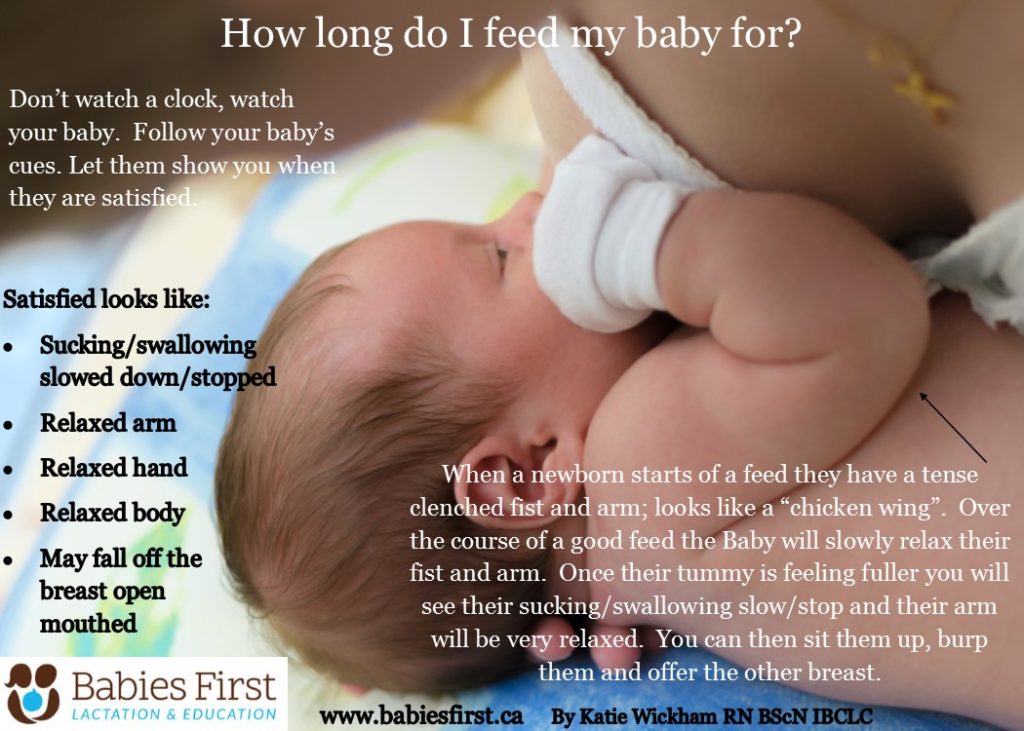
Something I see new Moms and Dads struggle with is how long a baby needs to feed at the breast to be full, satisfied and thrive. I have heard all different numbers from my clients: 10 minutes each side, 20 minutes each side, 30 minutes one side. None of these times are correct for all babies; no one time fits all. Just like adults, each baby needs a different amount of time to eat. When I sit down to eat with friends and family, we all finish at different times; babies are the same. Timing feeds is misleading: it rarely provides an accurate measure of how much baby is taking in. If we were to take two three-day old babies and measure how much they had eaten during a 15-minute breast feed, one could take in 5ml and the other could take in 35ml; if we cut off the first baby at 15 minutes, he could be underfed. Timing also takes the focus off of your baby and learning to watch/listen to them and places it on numbers which can lead to more stress.
One of the most common reasons I am called in for in-home consultations is high weight loss in the first few weeks and/or a baby having trouble gaining weight by breastfeeding. I have seen Moms use the knowledge they were able to retain from their whirlwind visit to their Hospital for delivery, and stop a baby mid-feed at the 10- or 15-minute mark to burp the baby and switch sides. I have even seen a Mother set a 10-minute timer so she would remember to switch sides. Following the clock can lead you to cutting your baby’s feed short, or even feeding them past the point they are transferring milk. You may be stopping them when they were just getting in to a good suck-and-swallow pattern, or you may even be limiting their ability to take in all the milk they need.
Watching your baby for signs of satisfaction is a much more accurate way to gauge your baby’s satiety. Watch that baby has had a good, sustained suck-and-swallow pattern, and that they are actively feeding on the breast. Watch baby for a relaxed arm; a newborn’s arm will start a feed flexed tightly with a clenched fist, a “chicken wing”. Over the course of a good feed, your baby will slow down their sucking/swallowing pattern, relax their arm and fist, and some may even fall off the breast with a relaxed open mouth; this tells you Baby is full and happy. Once your baby gets in to this more relaxed state on the breast you can help them by performing breast compressions- ‘squeeze your breast-hold- then release the squeeze’ repeat a couple of these in a row. Watch to see if your baby increases the sucking and swallowing. If not you can sit your baby up and burp baby, mostly to wake so you can offer the other breast. Offering both breasts in the beginning allows baby to take in more milk, practice breastfeeding more, and give your milk supply extra stimulation. Your baby may not want the second breast at each feed, just like we don’t always want dessert with each meal but in the early weeks it is good to offer. Once your milk transitions, you also should feel relief in your breast from the start of a feed to the end.
Sometimes in the early days babies can be sleepy at the breast you can help them to stay actively feeding by using breast compressions and switching breasts- even going to each breast twice in a feeding to help them stay more awake and take in more milk. If they are sucking and swallowing no need to switch breasts until they slow down/stop.
Watch that sweet baby; they can tell you a lot!
Katie Wickham RN BScN, IBCLC
www.babiesfirst.ca
www.facebook.com/BabiesFirstLactationAndEducation
